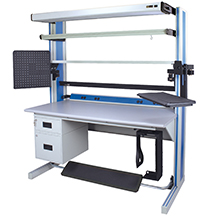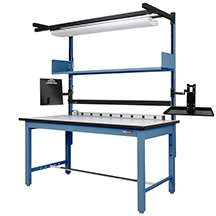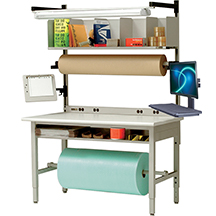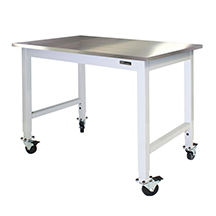Planning for Purchase Tips
When planning the design specifications for a workbench/workstation purchase, it is important to analyze and consider the key elements summarized below.
IAC has produced a convenient PDF questionnaire that expands on the list below and allows you to comprehensively identify the requirements and limitations of your workbench/workstation needs. We encourage you to download this document to thoroughly assess your next purchase. It can save you time and money, and ensure that your workbench purchase and implementation is a complete success.
Task considerations:
- What is the output or usage of this workstation? (Product description, material, description including size, shape & weight)
- Employee information: Number of shifts that use this workstation, number of workstation users per shift, hours of operation used daily
- Task information: Task description and work flow, specific goals to be met at each workstation?
- Is work performed seated? Standing? Both?
- Tools required: How many? Storage requirements? Air or electrical?
- Equipment used: Computer, monitor, mouse, keyboard? Test equipment? Describe size, weight, eye level, worksurface level. Equipment accessed from top? Side? Front? Back? Special electrical requirements of equipment?
Workstation Information:
- Required dimensions (L x W x H), including planned worksurface height, and upright heights (relative to ceiling clearance)
- How large is typical assembly on which work is performed? Size, shape, weight.
- ESD requirements? Cleanroom requirements?
- Height adjustability? Manual, hand crank, motorized.
- Shelving required? If so, describe purpose, size required, and preferred location.
Material Flow – both to and from workstation:
- Manually: By worker, by cart, gravity feed rack, other
- Direction of material flow – inbound and outbound
Utility Requirements:
- Electrical service: Above/below worksurface, number of outlets, AMPs, etc.
- Lighting: Ambient, task, adjustability – overhead, under shelf – power source
- Other Utilities: compressed air, fume extraction, etc.
Storage Requirements:
- Drawers: Quantity and size; weight capacity – tools or heavy items?; Security – locks required?
- Cabinets: Quantity and size; suspended or mobile; weight capacity; security
Facility:
- Type of flooring
- Floor space limitations (doors, windows, columns)
Other considerations:
- Facility: Type of flooring; floor space limitations; obstructions
- Privacy screens
- Tool trolleys, parts bin rails, location of documentation or work instructions; other above-worksurface needs
- Footrest - footrest pan
- Productivity Accessories, computer accessories
 Buy Online Now!
Buy Online Now!
 Buy Online Now!
Buy Online Now!










